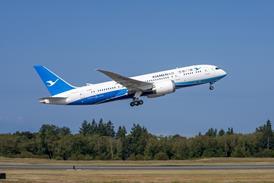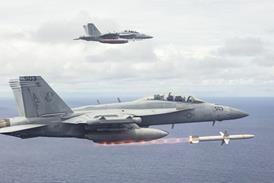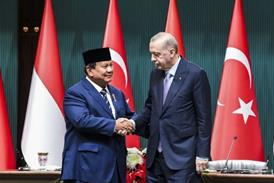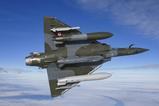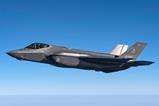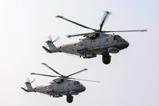Like a Nascar pit stop. That is how one former Saab Gripen and Viggen pilot describes the Swedish air force’s decades-old prowess in conducting road-strip operations.
Now the head of Saab Aeronautics’ advanced programmes business unit – and leading study work into the nation’s future combat aircraft technologies – Peter Nilsson refers to Stockholm’s ability to disperse its fighters as “extreme” agile combat employment (ACE).
The US Air Force is developing its ACE concept of operations in a bid to reduce logistics requirements and expand basing options ahead of any future near-peer conflict in the Asia-Pacific region. It describes this as “a proactive and reactive operational scheme of manoeuvre executed within threat timelines to increase survivability while generating combat power”.
Multiple other NATO and allied nations also are working to similarly increase their operating resilience, spurred on by lessons learned from the war in Ukraine. Examples include Poland, which late last year made its first landings on an ‘airport road section’ since 2003, with types including Lockheed Martin F-16s.
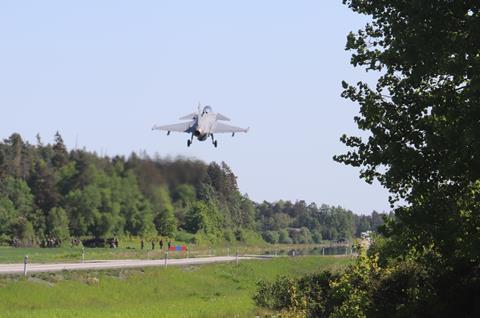
FlightGlobal visited a recent exercise staged by the Swedish air force’s F7 Wing, near its home at Satenas, during which the service demonstrated its off-base capabilities.
“It’s in our DNA,” says deputy air force commander Brigadier General Tommy Petersson of the operating technique involved. “We started to do these kind of dispersed operations in the 1960s, and we designed our Viggen and Gripen fighters for this.
“It was never really shut down after the Cold War ended,” he adds, “we kept the capabilities, but on a very small scale.”
REINSTATED OPERATIONS
Sweden formally reinstated its road-strip concept of operations after Russia’s annexation of Crimea from Ukraine in 2014, and having assessed the 2008 war in Georgia. Additionally, the nation reintroduced conscription in 2017, to bolster its personnel numbers. The air force brought in an intake of 800 youngsters for a year’s service in 2024, and plans to grow this figure to 1,000 soon.
“It’s not the [aircraft] take-off and landing that’s our priority,” notes Petersson. “It’s more the coordination of everything; the fuel and ammunition, and getting the right personnel to the right spot at the right time. This kind of operation demands a mission-command culture, with trust between different professions and at different levels.”
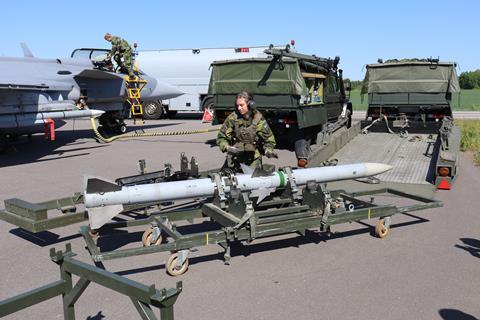
Current sensor and precision weapon capabilities mean that “no base area anywhere can be completely safe”, he says. “You need the capability to be able to disperse your assets at different locations.”
One of multiple such sites near Satenas and around Sweden, the short section of strengthened rural road used during the exercise is 1,000m (3,280ft) long – representing a usable surface of 800m, with a 100m safety buffer at either end – and just 17m wide.
The 800 x 17m dimensions were established for the larger Viggen, which differed from its successor by featuring a thrust reverser, which assisted with short landings.
“There is no other fighter in the western world that is certified to land on an 800m runway – it’s only the Gripen that can do that,” Petersson notes.
PAST EXPERIENCE
Sweden was able to demonstrate such austere performance during the NATO-led Unified Protector campaign over Libya in 2011, when it operating philosophy proved of benefit. After a landing accident involving an F-16 temporarily closed the single runway at Sigonella in Sicily, deployed Gripens were still able to take off using a taxiway.
The same capability will be retained with the larger and heavier Gripen E, 60 of which are on order for Sweden, for service introduction from 2025. The new version has yet to undergo road trials, but will have a faster touchdown speed than the current, lighter model.
Petersson says the air force wants to increase its ability to perform dispersed operations, but that this will require further resources and investment in terms of personnel and equipment. As an example, of the four road strips previously built near Satenas, only one is currently available for use.

Being able to operate on a road strip is part of a new pilot’s combat readiness training to become a wingman, explains F7 boss Wing Commander Adam Nelson.
Touching down on such a short and narrow strip requires extreme precision: the aircraft must make contact no more than 30-50m beyond the aim point, noted by the use of blue and red marker boards. Approaches are performed with an angle of attack of 14°: slightly steeper than the 12° normally flown with the Gripen C/D, and with its touchdown speed being around 200kt (370km/h).
Prior to conducting live landings, pilots perform training using a simulator and an 800 x 17m area marked out on the runway at Satenas.
“It gives a bit of extra stress to the pilot, but it’s not very difficult,” Nelson says of the landings. “You have the sense that the trees are very close to your sides, and you have the visual impression that the runway is shorter.”
The aircraft can perform such operations even while carrying heavy stores, like Saab’s RBS15 anti-ship missile.
Once on the ground, each jet turns in the road and taxis back to a small layby, to be met by a support team typically with only four or five personnel. During the recent exercise – the second staged so far this year near Satenas – this comprised one full-time technician and maintainer, plus three conscripts conducting their military service.
Prior to arriving at the refuelling/rearming site, the team’s specialist military vehicles rendezvous nearby with a commercial truck carrying missiles. These are transferred to their vehicles’ trailers via a crane arm, and – in the case of Raytheon AIM-120 AMRAAMs – then have their control fins fitted.
During the exercise, a pair of fighters were each rearmed and refuelled in just over 15min, before swiftly departing again.
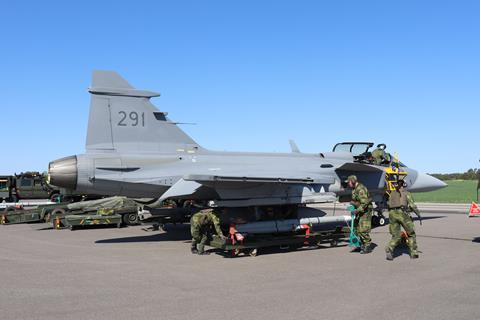
Ground operations are performed without heavy machinery – notably, maintainers use a hand-cranked tool nicknamed the “fishing rod”. This can be employed while loading the fighter’s air-launched weapons and gun unit, replacing its engine and auxiliary power unit, and also during work on the main landing gear.
The exercise routine sees the small section of road closed to traffic in the morning – vehicles are diverted only a short distance away, in sight of the landing strip. The surface is prepared using a large wheeled vehicle with a runway-clearing brush attachment, and then monitored during operations to prevent foreign object damage.
Meanwhile, control of the air around and approaching the road strip is maintained by reservist mobile air traffic controllers, who oversee operations from beside the landing point. Post-exercise assessments look at the placement of tyre marks, to ensure pilots have touched down correctly, and in the centre of the road.
Such road landings are not performed in all weather conditions, with minima in place for both visibility and surface control, but can be performed on ice.
“NATO [membership] isn’t going to make it stop snowing in the north of Sweden,” Nilsson notes. Sweden completed the accession process to join the western military alliance in early March, becoming its 32nd member.
Road landings also are not conducted during the hours of darkness, as the strips do not have lighting.
WIDER INTEREST
“We have a lot of visits and a lot of interest from allies and other countries that we work with” to learn about dispersed operations, Nelson says. This includes launch Gripen E operator Brazil, which could in the future explore the potential for conducting such tasks with its locally-named F-39E/Fs.
From an operational perspective, Nelson explains: “We would try to disperse all parts of the base logistics and command and control operations the same way as the aircraft. We would typically try to be below ground, and move things around.
“We would move from one runway to the other from one day to the next.”
Sweden has an active fleet of just under 100 Gripen C/Ds, with operating squadrons at its Lulea, Ronneby and Satenas bases. The service plans to boost that strength to 120 aircraft via its introduction of 60 E-model fighters, which will be supported by continuing operations with 60 C/Ds.

The importance of being able to rapidly move valuable assets to prevent them from being hit on the ground is among the key lessons learned by allies during the current conflict in eastern Europe.
“What you saw in the first 24h in Ukraine was that everything with a fixed location was targeted with sufficient precision, but everything that was moved 24h before was not hit. Air defence systems and aircraft that were moved survived,” Nelson notes.
In addition to claiming that the Gripen is unmatched while operating under such conditions, Swedish officials note that other advanced fighters, and particularly Lockheed’s F-35, require a large volume of support personnel and equipment when operating away from a home base.
Being able to disperse such aircraft but still having to rely on extensive support requiring multiple transport aircraft and a large team of maintainers means that for many, the ACE concept is far from delivering on its goals.
Discussing other air forces’ use of much longer and wider road sections – such as dual-lane highways or even air bases – to conduct ACE-type trials, one Gripen pilot quips: “That’s not sport!”




